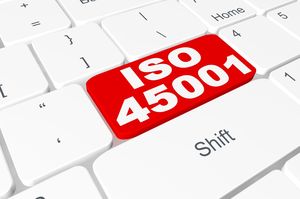KANBrief 2/18

ISO 45001:2018-03 "Occupational health and safety management systems – Requirements with guidance for use" was published on 12 March 2018 by the International Standards Organization (ISO). In some quarters, the response to the standard’s appearance has been “a star is born”; other affected parties in industry and occupational safety and health have taken a more nuanced view. Opinions on the document now published differ widely. A common translation for Germany, Austria and Switzerland was published in June 2018.
As long ago as the late 1990s, various endeavours were being made by ISO and the British Standards Institute (BSI) to launch development of a standard for OSH management systems. Not until the spring of 2013 however was a majority attained at ISO for creation of the ISO/PC 283 project committee, by which an international standard was to be prepared under British leadership (BSI) based upon the familiar British OSH standard, OHSAS 18001. It soon became apparent that mere revision of the content was neither opportune, nor would it have satisfied the formal requirements of ISO, which had changed in the interim.
A total of 69 national standards organizations (participating members) were actively involved in the process of developing the standard. The participants came from European countries, including Italy, France and Germany, countries in North and South America, and also from Australia and Africa. Observers and members of other ISO committees also attended. Liaison organizations such as the International Labour Organization (ILO) were closely involved in the development process through a memorandum of understanding; they were consequently also able to exert particular influence upon the standards development project, which led at times to heated discussions at the plenary sessions. Almost 10,000 comments were received, presenting a major challenge for all concerned.
The German mirror committee, DIN working committee 175-00-02, “Occupational health and safety management systems”, supervised the development in the Standards committee for organizational processes (NAOrg). The stakeholders represented on that committee also agreed to adopt ISO 45001 as a national standard, DIN ISO 45001, following its publication.
Like the updated ISO standards 9001:2015 "Quality management systems – Requirements" and 14001:2015 "Environmental management systems – Requirements with guidance for use", the standard follows the new high-level structure requirements of the ISO/IEC (directives Annex SL, ISO/IEC Directives, Part 1: Consolidated ISO Supplement – Procedures specific to ISO) with regard to the formal requirements and thus to its structure. This shared high-level structure is intended to ensure that standards developed or revised in the future have the same structure and equivalent requirements for their common topics. It was therefore fitting for harmonization with standards governing quality management and environmental management systems to be an objective during the development of ISO 45001.
The national foreword of DIN ISO 45001 makes clear that the standard can have only a supplementary role in the European and national bodies of occupational safety and health regulations. Besides the foreword and in accordance with HLS guidance, ISO 45001 contains ten chapters (Scope, Normative references, Terms and definitions, Context of the organization, Leadership and worker participation, Planning, Support, Operation, Performance evaluation, Improvement). These are followed by the informative Annex A, which provides guidance on application of the standard.
The content exhibits a clear shift towards the imposition of greater requirements upon the organizations. The following aspects are new to the standard, particularly in comparison with the familiar OHSAS 18001:
ISO 45001 is an OSH management system standard, not an OSH standard. It is not intended to govern specific OSH requirements, such as those familiar from legislation or the regulations of the accident insurance bodies. Conflict or competition with national and/or European bodies of regulations must not arise.
Uwe Marx Eckhard Metze